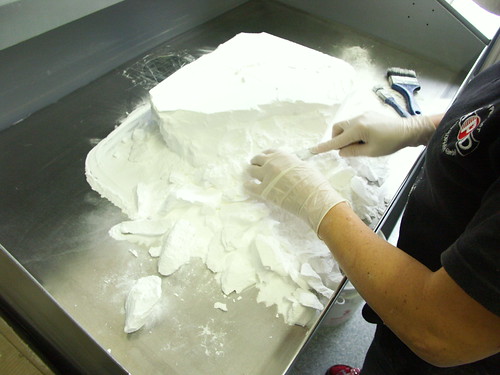Powder laser sintering or SLS (Selective Laser Sintering) is a process which makes it possible to manufacture products using materials in powdered form. These materials are often made of plastic substances such as nylon, for example. SLS 3D printers are equipped with an interior sliding metal arm which distributes the powdered material on to the printing platform. The 3D file directs the laser on to the powdered substance at specific points which heats the material to very high temperatures (just below boiling point) and fuses the powdered particles, transforming the material into solid form The laser traces the layers of the object and once the material has been solidified the printing platform is lowered by a distance which equals the thickness of a layer. The sliding metal arm then dispenses more powder on to the platform which is then heated by the laser with the entire process being repeated until every layer has been completed. (The number of layers depends on the size of the object and the resolution of the SLS 3D printer).
 source: MaterialGeeza via Wikipedia
source: MaterialGeeza via Wikipedia
Once the selective laser sintering process has been completed and the object has been printed, it is left to cool in the receptacle for the powdered material before being handled.
La résolution des pièces (l’épaisseur des couches solides) varie de 50 à 150 microns, en fonction de la précision de la machine utilisée.
The resolution of the object, i.e. the thickness of each solidified layer ranges between 50 and 150 microns and depends on the precision of the printer used. Powder sintering makes it possible to produce objects using a wide range of materials although in practice, there are slight differences between the technologies used (SLS only involves the sintering of polyamide powder) the procedures are very similar to each other. It is possible, for example to effect metallic sintering using DMLS technology which can also be used to create ceramic objects.
| Property | Frittage Laser |
| abbreviation | SLS |
| Type of Material | Poudre Polymère |
| Materials used | Thermoplastics such as Nylon, Polyamide, and Polystyrene; Elastomers; Composites |
| Maximum object size (in cm) | 55 x 55 x 76 |
| Minimum characteristic size (po) | 0.005 |
| Maximum Resolution | 0.01016 |
| Tolerance (in cm) | ±0.0254 |
| Finishing | Moyen |
| Printing speed | Rapide |
| Applications | Form/fit testing, Functional testing, Rapid tooling patterns, Less detailed parts, Parts with snap-fits & living hinges, High heat applications |
The production of objects using the powder sintering process offers a number advantages including:
A reduction in the amount of equipment used which in turn significantly reduces the number of qualified personnel required once the printing process has been completed.
The ability to produce objects without requiring a support during the selective laser sintering process. This is due to the fact that the solid object is continuously immersed in the powder which has not been sintered which supports it as it is built layer by layer. The printing and handling times are therefore significantly reduced compared to other methods such as stereolithography.
 source: Shapeways via Flickr
source: Shapeways via Flickr
 source: Fluid Forms via Flickr
source: Fluid Forms via Flickr
### SLS: applications
### SLS: sectors